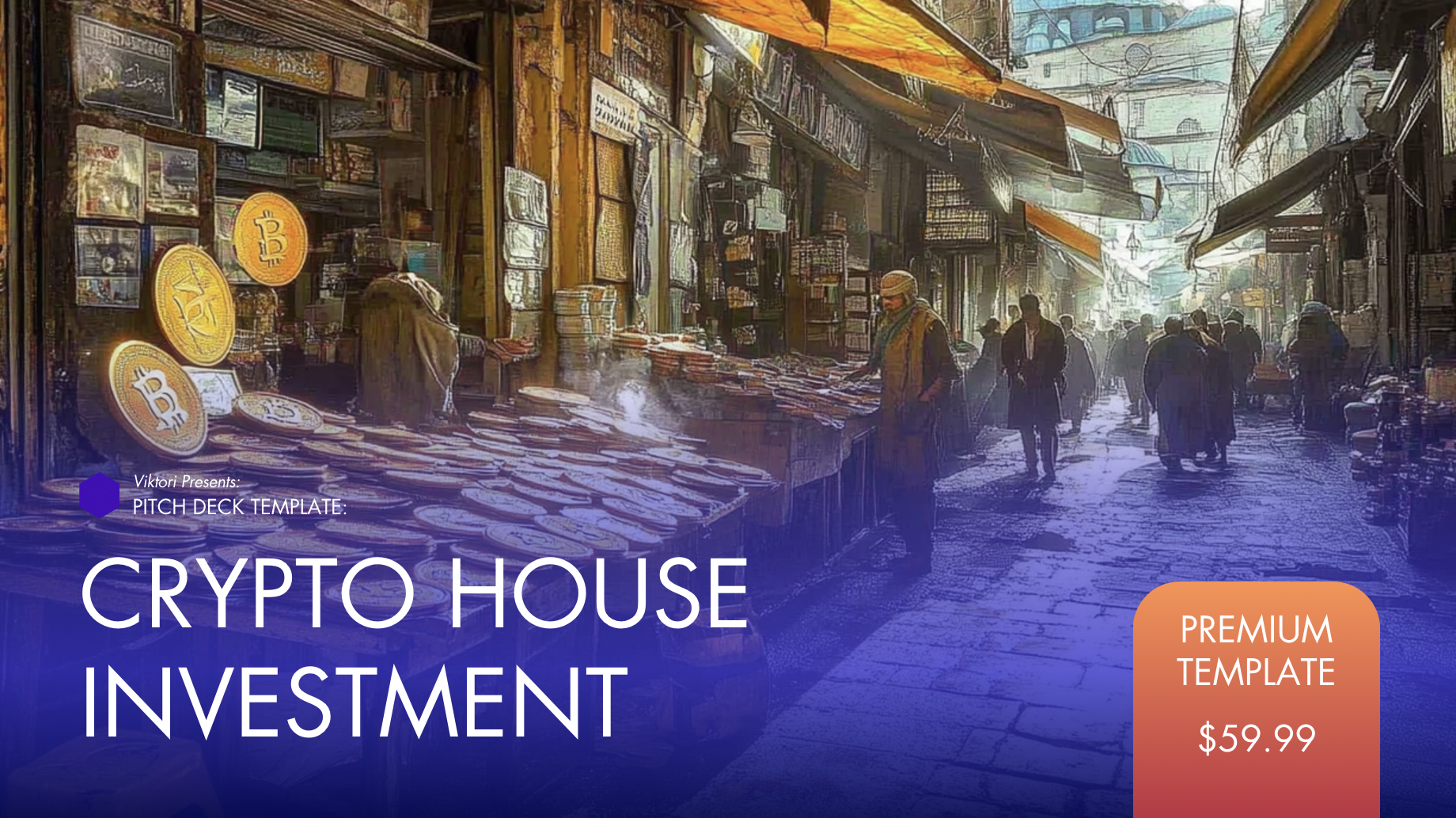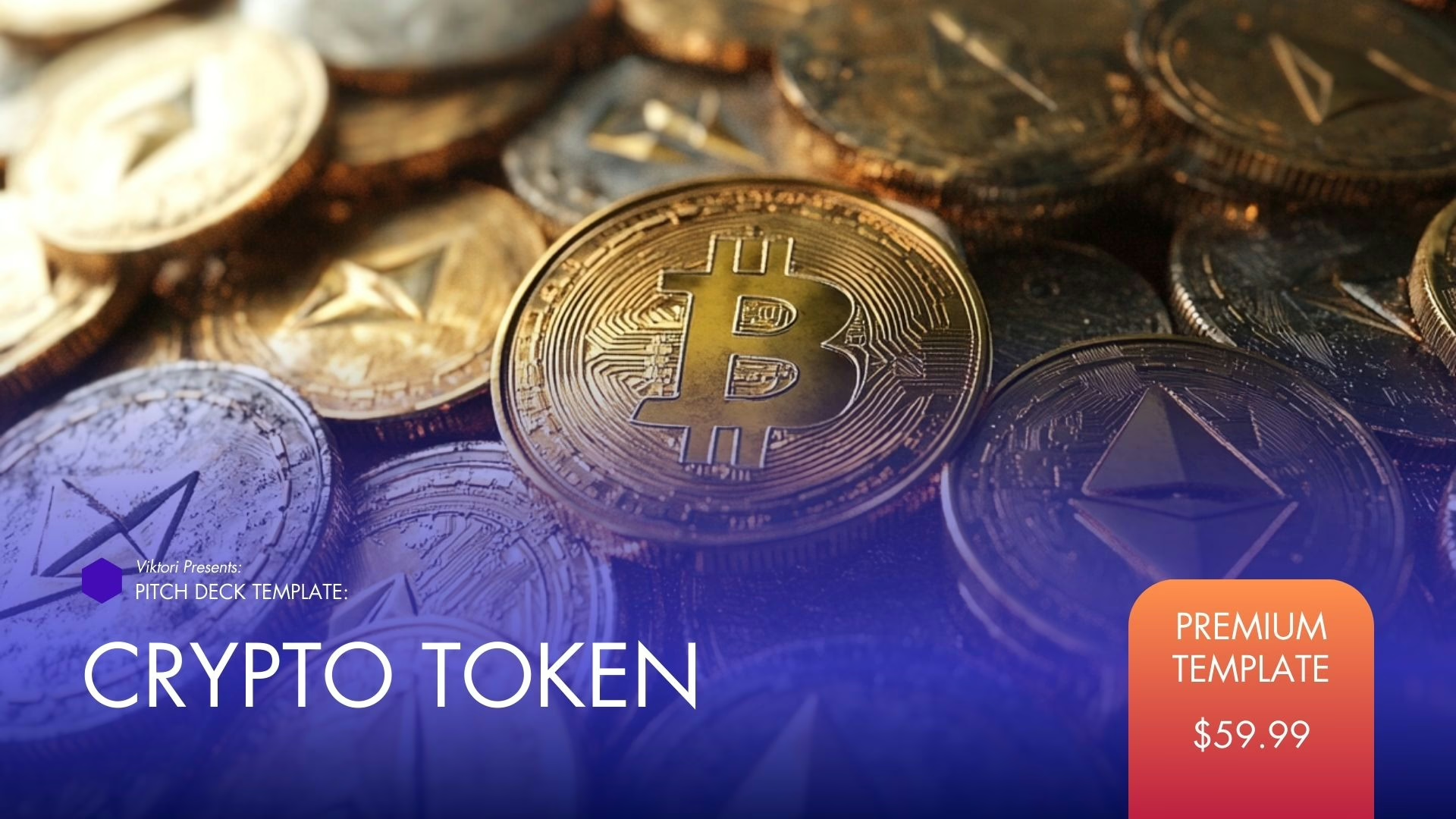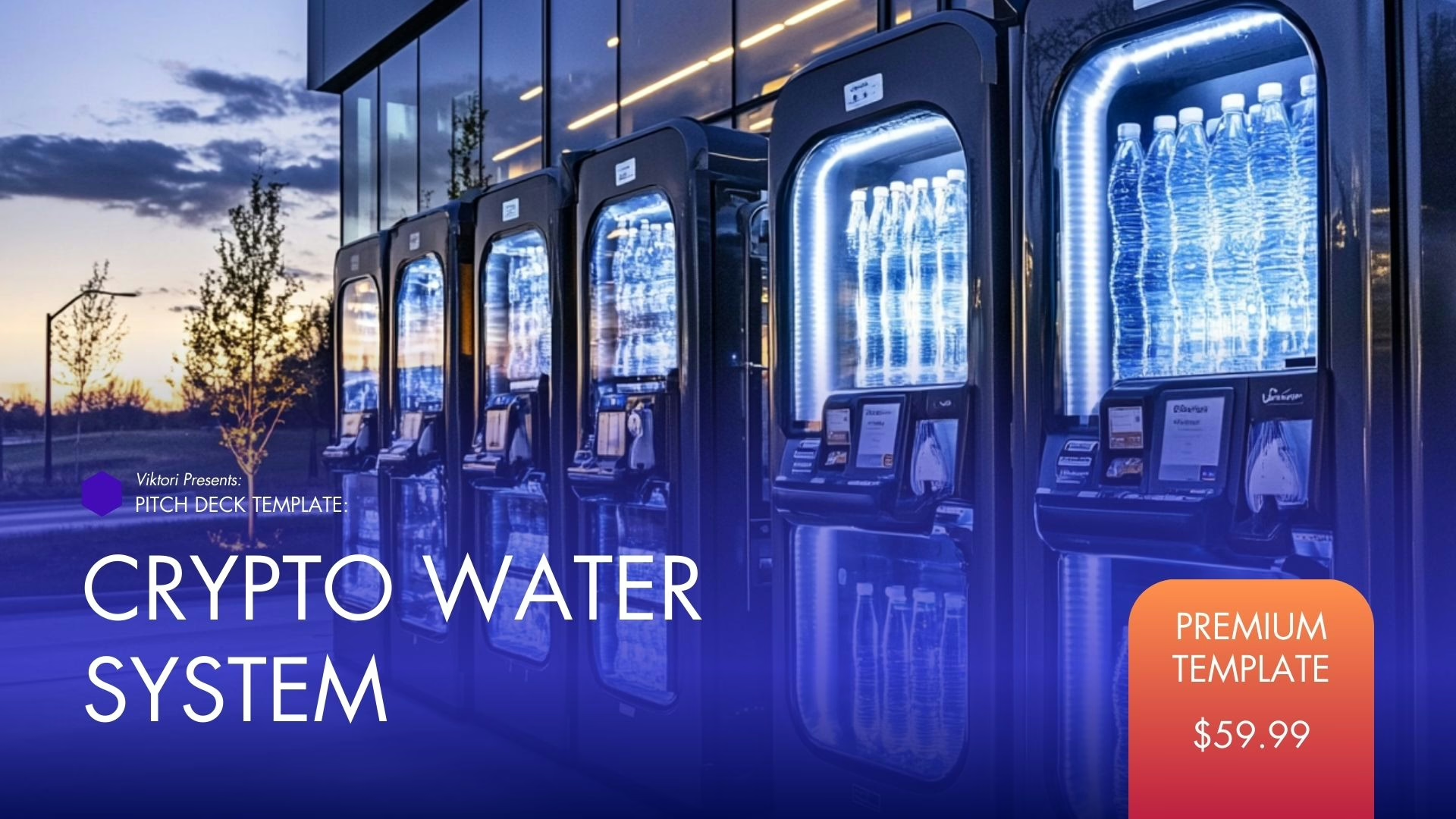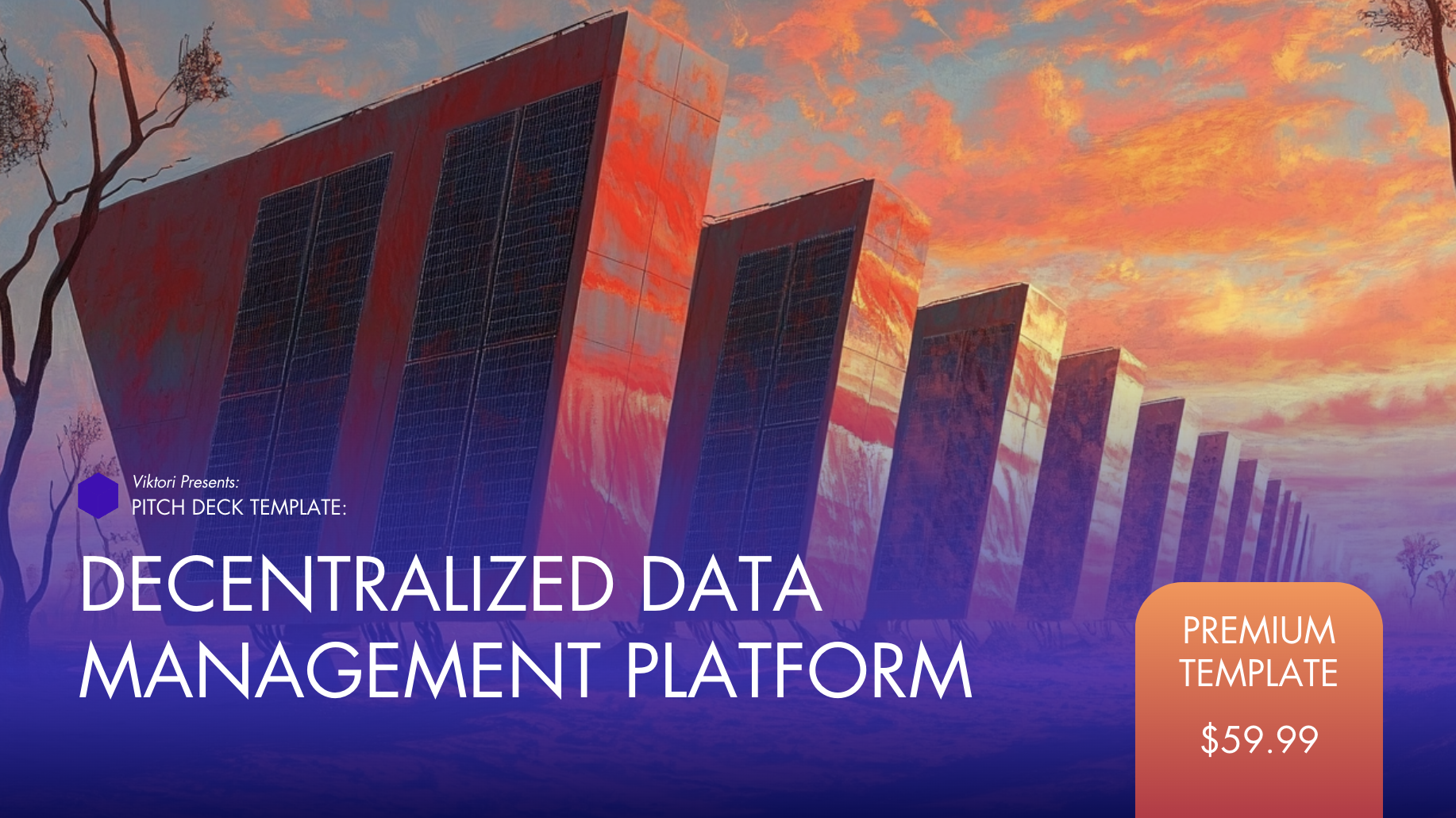
How To Create A Crypto Pitch Deck (Template & Examples Incl)

Author: Viktor
Pitch Deck Expert. Ex Advertising. Founder of Viktori. $500mill In Funding. Bald Since 2010.
You’ve got the next big idea for a crypto project—maybe it’s a revolutionary DeFi platform, a game-changing NFT marketplace, or a blockchain-based app that’ll make Elon Musk tweet about it.
But here’s the kicker: no one’s biting. And no, it’s not because “people don’t get your vision.”
It’s because your pitch deck sucks. Harsh? Sure. True? Also, yes.
Hey, I’m Viktor. Nerd, pitch deck expert, and someone who’s helped clients raise over $500 million in funding. I’ve seen killer projects die in silence because their founders couldn’t explain their ideas in a way that makes investors want to throw money at them.
And I’m here to make sure that doesn’t happen to you.
So, why should you care about this guide?
Because in the wild west of crypto, your pitch deck is your golden ticket. It’s the difference between landing that seed round and becoming the next big thing or… quietly fading into the abyss of forgotten blockchain dreams.
In this guide, I’m going to break down exactly how to create a crypto pitch deck that’ll make VCs and angel investors lean forward in their chairs. Here’s what we’ll cover:
- What even is a pitch deck? (Hint: It’s not just a PowerPoint with a fancy font.)
- 5 proven steps to create an effective deck (we’re talking clear messaging, epic visuals, and storytelling that hits harder than Bitcoin in 2017).
- Real-world examples and templates to fast-track your success—because let’s be honest, you probably needed this done yesterday.
Oh, and if you’re worried I’m just throwing buzzwords at you, let me hit you with some stats. Did you know that 75% of pitch decks fail to secure funding simply because they’re unclear or boring? That’s right. Investors don’t have the time—or patience—for anything that doesn’t immediately grab their attention. But don’t sweat it, by the end of this guide, you’ll have a pitch deck that’s polished, professional, and impossible to ignore.
Ready to make investors FOMO into your project? Let’s dive in.
What is a Crypto Pitch Deck?
A crypto pitch deck is your ultimate power move to secure investment, partnerships, or sales for your blockchain-based project. It’s a strategic weapon that communicates why your idea deserves attention (and funding) over the hundreds of other crypto projects vying for the same spotlight.
Why is a Pitch Deck Essential for A Crypto Project?
Whether you’re gunning for funding, courting potential buyers, or building trust with stakeholders, your pitch deck is often the first impression you make.
And let’s be real, in a market flooded with buzzwords like “decentralized” and “immutable,” standing out isn’t optional—it’s survival.
Here’s why a pitch deck is your secret weapon in the crypto space:
1. Securing Funding from Investors
Investors see dozens of crypto pitches every week, and you have less than 3 minutes to grab their attention. A well-designed pitch deck helps you communicate your project’s value quickly, clearly, and convincingly.
- 75% of investors admit they prefer presentations with clear, visually engaging storytelling, according to research by DocSend.
- Crypto-specific funding has grown exponentially—venture capital investments in blockchain hit $26 billion in 2021 alone, according to CB Insights. To compete, your pitch deck must cut through the noise and articulate why your project is worth their bet.
Your deck isn’t just about numbers; it’s about creating a compelling narrative around your project. For example:
- Showcase how your DeFi protocol solves liquidity issues or how your NFT marketplace enables creators to thrive.
- Use visuals like charts, infographics, and product screenshots to make abstract blockchain concepts tangible.
In short, if your pitch deck doesn’t resonate, your project won’t even make it to a follow-up meeting.
2. Presenting Deals to Potential Buyers
Whether you’re looking to partner with exchanges, onboard institutional investors, or pitch enterprise clients, your deck has to make the case for why your solution matters.
- For example, if you’re developing a blockchain platform for supply chain management, your deck needs to clearly explain how your solution reduces inefficiencies, saves costs by X%, or improves transparency in Y industries.
- Buyers want data, scalability insights, and a roadmap that assures them your project is viable. A strong pitch deck gives them the confidence they need to move forward.
Beyond selling the project, your deck also demonstrates how well you understand the crypto market, which is a major trust factor. If you can’t explain your value proposition in 10 slides, why would they trust you to execute it?
3. Building Trust and Credibility with Stakeholders
In the crypto world, trust is the ultimate currency. The industry is notorious for scams, rug pulls, and vaporware (thanks, 2017 ICO boom). A polished pitch deck signals to stakeholders—whether they’re investors, partners, or early adopters—that you’re serious, professional, and transparent.
How does it do that?
- Clarity builds trust. Your pitch deck shows you’ve done your homework by presenting a detailed problem-solution framework, robust tokenomics, and a clear use of funds.
- Professionalism fosters credibility. A deck that looks clean and organized (as opposed to slapped together last minute) makes people take your project more seriously.
- Transparency earns respect. By including information on your team, roadmap, and revenue model, you’re signaling that you’re an open book.
According to a report by Edelman, 60% of investors say trustworthiness is the #1 factor in deciding whether to invest. Your pitch deck is often the first step in building that trust.
Real-World Impact: Why Crypto Startups Can’t Skip the Deck
Take OpenSea as an example. Before becoming the largest NFT marketplace in the world, OpenSea used a simple yet effective pitch deck to raise its seed funding in 2018. It communicated the value of NFTs, the problem it was solving (lack of platforms for digital ownership), and the opportunity in a rapidly growing market. Fast forward to today, and they’ve raised $423 million in total funding. That started with a pitch deck.
Step-by-Step Guide to Creating a Winning Crypto Pitch Presentation
Step 1: Define Your Objective
Before you even open PowerPoint, ask yourself: What am I trying to achieve with this pitch deck? Clarifying your objective isn’t just helpful—it’s essential. A crypto pitch deck can serve multiple purposes, and tailoring your content to match your goal ensures your message lands effectively. Here are some common objectives in the crypto space:
1. Securing Investment
The most common objective for a crypto pitch deck is to attract funding. This includes:
- Seed funding: Early-stage capital from angel investors, crypto-focused funds, or even crowd sales.
- Series A/B rounds: Raising larger amounts to scale operations, grow your user base, or expand into new markets.
- Venture capital (VC): Targeting traditional or crypto-focused VC firms like a16z Crypto, Pantera Capital, or Paradigm.
- ICO/IDO/IEO fundraising: For tokenized projects, your pitch deck might also double as a key piece of collateral in marketing to retail investors during an Initial Coin Offering (ICO), Initial DEX Offering (IDO), or Initial Exchange Offering (IEO).
2. Securing Partnerships
Not every crypto pitch deck is about raising cash. Sometimes it’s about forming strategic partnerships that amplify your project’s reach or capabilities. For example:
- Tech partnerships: Collaborating with Layer 1 or Layer 2 blockchains (e.g., Solana, Ethereum, Polygon) to use their infrastructure.
- Platform integrations: Showing wallets, exchanges, or dApps why your solution complements their existing ecosystem.
- Institutional adoption: Persuading financial institutions, enterprises, or governments to use your blockchain solution for specific use cases like supply chain transparency or payments.
3. Building Brand Awareness and User Adoption
Your goal might not involve raising money directly but instead creating buzz or acquiring early adopters:
- Targeting community growth: Building a community of token holders, developers, or supporters around your project.
- Product adoption: Attracting businesses, creators, or users to your platform, marketplace, or protocol.
- Thought leadership: Positioning your project as a visionary solution in a specific niche, like DeFi, GameFi, or RegTech (Regulatory Technology).
4. Pitching to Buyers or Acquirers
In some cases, your pitch deck is about positioning your company for an acquisition or merger. You’ll need to highlight your market traction, competitive advantage, and scalability to show potential buyers why acquiring your project is a smart move.
Pro Tip:
Each objective requires a slightly different tone, structure, and focus. If you’re targeting investors, they care about scalability, market potential, and ROI. For partnerships, you’ll want to highlight synergies and integration potential.
Step 2: Know Your Audience
Crypto investors and stakeholders are not a one-size-fits-all group. Your deck needs to speak directly to the priorities, interests, and concerns of your specific audience. Without this level of focus, your message might miss the mark entirely. Here’s how to tailor your pitch deck based on audience type:
1. Types of Audiences in the Crypto Industry
Institutional Investors:
These include VCs, hedge funds, or private equity firms. They’re focused on long-term ROI, market timing, and the scalability of your solution. Show them:
- How your project fits into existing trends (e.g., DeFi, NFTs, CBDCs).
- The growth potential of your market.
- Clear tokenomics and mechanisms for value appreciation.
- Examples of current traction, like partnerships or user growth.
Angel Investors and Crypto Whales:
High-net-worth individuals or early adopters in crypto who are more risk-tolerant. They care about:
- Early entry opportunities.
- Potential for outsized returns (e.g., “Token prices projected to grow X% in Y years”).
- Unique or disruptive aspects of your project.
Crypto-Focused VC Funds:
Specialized funds like a16z Crypto, Pantera Capital, or Coinbase Ventures focus exclusively on blockchain investments. They value:
- Your technical edge or innovation.
- How your project compares to competitors.
- Your roadmap and technical development milestones.
Corporate Partners/Enterprise Clients:
These are companies looking for blockchain solutions to solve specific problems. For example, a logistics company might care about supply chain transparency, while a gaming company is interested in NFTs. Focus on:
- Practical applications of your technology.
- Cost savings or efficiency gains for their business.
- Ease of integration with their current systems.
Retail Investors/Community Members:
Retail investors participating in ICOs or IDOs are looking for reasons to believe in your vision. They care about:
- Your mission and potential impact.
- Your community-building efforts (Discord groups, Telegram chats, social media engagement).
- Transparent communication about token utility and use cases.
2. Audience-Specific Concerns and Priorities
Your deck should address the unique concerns of your target audience. Here are some examples tailored to the crypto industry:
-
ROI Concerns:
For institutional or angel investors, show clear projections for token value appreciation, business growth, or revenue generation. Include tangible data to support your claims. -
Market Trends and Fit:
Investors want to know how your project aligns with emerging trends. Highlight how your solution taps into areas like decentralized finance (DeFi), Layer 2 scaling, NFTs, or regulatory compliance (e.g., MiCA, FATF). -
Scalability:
Can your project handle mass adoption? Highlight tech scalability (e.g., TPS performance for blockchains) or roadmap milestones that expand your reach. -
Regulatory Risks:
Crypto investors are hyper-aware of regulatory challenges. Address potential issues upfront, like your compliance with GDPR, AML/KYC standards, or future-proofing against regional bans. -
Competition:
Investors will ask: Why you over everyone else? Address this by identifying competitors and explaining your unique edge. For example: “Unlike [Competitor A], our protocol enables X, which reduces costs by Y%.” -
Tokenomics & Revenue Models:
If your project involves a token, explain its utility in detail. For revenue models, clarify how the project generates sustainable income (e.g., transaction fees, staking rewards). -
Execution Team & Track Record:
Crypto is littered with projects led by anonymous founders. If you have a strong team with verifiable experience in blockchain, crypto, or tech, emphasize this heavily to build trust.
Pro Tip:
Personalize your deck for each audience type. For example, if you’re pitching to a corporate partner, they won’t care about tokenomics—but they’ll care a lot about cost reductions or integration capabilities. Similarly, angel investors are likely to respond to visionary storytelling, while institutional VCs want data-backed projections.
By knowing who you’re pitching to and addressing their specific concerns, you’ll create a deck that feels custom-made—and leaves a lasting impression.
Step 3: Use This 12 Slide Pitch Crypto Deck Template
This 12 slide pitch deck template is perfectly crafted to fit 80% of all crypto deals. If you need a tailor made template, I left a note on where you can ask for it, below. Alternatively, check out our database of pre-made crypto pitch deck templates.
Slide 1: Elevator Pitch
Headline: “Revolutionizing Finance Through Decentralization”
- Content:
- Problem: “Traditional financial systems are costly, exclusive, and vulnerable to fraud.”
- Solution: “We deliver a secure, transparent, and accessible blockchain solution empowering users worldwide.”
- Key Differentiator: “Built on scalable blockchain technology, we solve the ‘trilemma’ of security, decentralization, and scalability.”
- Visuals: A sleek network graphic showing interconnected nodes representing blockchain security.
- Design Tip: Keep this slide minimalistic; focus on your core message.
If you need more tips on how to build this slide, check out my elevator pitch article.
Slide 2: Investor Highlights
Headline: “Why Invest in Us?”
- Content:
- Market Potential: “Targeting a $1T blockchain-driven economy with XX% CAGR growth.”
- Product Traction: “Over 100,000 active users, 500K transactions processed in 2024.”
- Strategic Partnerships: “Collaborating with top exchanges and DeFi protocols.”
- Revenue Model: “Clear path to profitability with tokenomics and platform fees.”
- Experienced Team: “Led by veterans from top blockchain firms and fintech leaders.”
- Visuals: Use icons or infographics to depict each highlight.
- Design Tip: Ensure this slide is data-rich but not cluttered. Bold headlines and minimal text work best.
Slide 3: Market Overview
Headline: “A $1 Trillion Opportunity Waiting to Be Captured”
- Content:
- Total Addressable Market (TAM): “The blockchain economy is growing at XX% annually.”
- Addressable Use Cases: “DeFi, cross-border payments, tokenized assets, gaming, and more.”
- Trends Driving Growth: “Web3 adoption, institutional crypto adoption, and decentralized identity solutions.”
- Visuals:
- A pie chart or bar graph showing TAM, SAM, and SOM.
- Include trend graphs showing growth in crypto adoption over the last 5 years.
- Design Tip: Keep visuals colorful yet professional; use contrasting colors to highlight key data points.
Slide 4: Problem
Headline: “The Challenge with Finance Today”
- Content:
- High Costs: “$120B spent annually on cross-border payment fees.”
- Exclusivity: “2 billion people globally remain unbanked.”
- Security Risks: “$4B lost in financial fraud in 2023 alone.”
- Current Crypto Gaps: “Scalability and usability issues prevent mass adoption.”
- Visuals:
- Infographic comparing traditional finance (slow, expensive, exclusive) vs. crypto potential (fast, low-cost, inclusive).
- Design Tip: Leverage emotional appeal with relatable stats and imagery that resonate with the audience.
Check out the problem slide article for more tips.
Slide 5: Solution
Headline: “The Blockchain Platform Built for the Future”
- Content:
- “Our platform combines scalability, security, and decentralization to deliver financial freedom to all.”
- Core Innovations:
- “Layer-2 scalability enables 100,000+ TPS.”
- “Smart contracts allow seamless DeFi integration.”
- “Low fees: Transaction costs reduced by 85%.”
- User Benefits:
- “Instant transfers, robust security, and borderless access.”
- Visuals:
- Before-and-after visual: financial landscape without vs. with your solution.
- Flowchart of how your technology works in action.
- Design Tip: Showcase a strong and simple visual impact—e.g., motion graphics or animations.
Check out the solution slide article for more tips.
Slide 6: How It Works
Headline: “Effortless and Scalable Blockchain Ecosystem”
- Content:
- User Interaction:
- “Users onboard with a single wallet setup.”
- “Simple interfaces for seamless transactions.”
- Technology Backend:
- “Layer-2 architecture processes 100K TPS.”
- “Uses cutting-edge consensus mechanisms for energy efficiency.”
- Ecosystem Integration:
- “Compatible with existing DeFi protocols and traditional finance APIs.”
- User Interaction:
- Visuals:
- Step-by-step diagram of the user journey, starting from wallet creation to final transactions.
- Include a high-level architectural design showing scalability and security.
- Design Tip: Highlight clarity—avoid overly technical jargon; rely on visuals to simplify the flow.
Slide 7: Technology Advantage
Headline: “Innovating Beyond the Blockchain Status Quo”
- Content:
- Proprietary Technology: “Revolutionary consensus mechanism achieving unparalleled scalability and security.”
- Energy Efficiency: “Consumes 80% less energy than traditional PoW systems.”
- Interoperability: “Seamlessly integrates with Ethereum, Binance Smart Chain, and others.”
- High Security: “Quantum-resistant cryptography ensures future-proofing.”
- Visuals:
- A comparative chart showing key technical advantages over competitors (e.g., Ethereum, Solana).
- A visual diagram of your tech stack highlighting unique layers or protocols.
- Design Tip: Use clean graphics to emphasize the superiority of your technology.
Slide 8: Traction
Headline: “Proving Success with Early Wins”
- Content:
- Key Metrics:
- “500,000 transactions processed monthly.”
- “$10M in total locked value (TVL) across protocols.”
- Partnerships:
- “Collaborating with [Partner Name] for DeFi integration.”
- Community Growth:
- “50,000+ active wallet holders and counting.”
- Media Mentions:
- “Featured in [TechCrunch, CoinDesk].”
- Key Metrics:
- Visuals:
- Line graph showing user growth, transaction volume, or revenue trends.
- Screenshots or logos of partners and media coverage.
- Design Tip: Focus on visually showcasing growth metrics; make numbers pop with bold colors.
Check out the traction slide article for more tips.
Slide 9: Business Model
Headline: “Building Value for Users and Investors”
- Content:
- Revenue Streams:
- “Transaction fees: Earned per processed transaction.”
- “Staking: Revenue from validator rewards.”
- “Token Sales: Driving liquidity and adoption.”
- Scalability:
- “Low costs and high throughput allow exponential growth.”
- User Retention:
- “Gamified staking programs drive ongoing participation.”
- Revenue Streams:
- Visuals:
- Flowchart showing revenue streams with percentage breakdowns.
- Include a user value journey from onboarding to monetization.
- Design Tip: Keep it simple but professional; focus on the sustainability of your business model.
Slide 10: Team
Headline: “Led by Visionaries, Built by Experts”
- Content:
- Key Team Members:
- “[Name, Role]: 10+ years in blockchain development.”
- “[Name, Role]: Ex-[Company Name], fintech strategist.”
- Advisors:
- “[Name]: Renowned crypto investor, founder of [Fund Name].”
- Team Strength:
- “Combined experience across blockchain, AI, and finance.”
- Key Team Members:
- Visuals:
- Photos of team members with brief bios underneath.
- Include advisor logos or institutional affiliations.
- Design Tip: Create a balance between professional and approachable visuals to build trust.
Slide 11: Roadmap
Headline: “Our Vision for the Next 5 Years”
- Content:
- Short-Term Goals (Year 1):
- “Launch mainnet and onboard 50K users.”
- Mid-Term Goals (Years 2-3):
- “Expand DeFi partnerships and reach 500K users.”
- “Integrate with global payment networks.”
- Long-Term Goals (Years 4-5):
- “Become the backbone of decentralized finance with $1B in TVL.”
- Short-Term Goals (Year 1):
- Visuals:
- A timeline with milestones and progress markers.
- Highlight key achievements with icons or badges.
- Design Tip: Use colors or gradients to visually separate short-, mid-, and long-term goals.
Slide 12: Call to Action
Headline: “Join the Revolution in Financial Freedom”
- Content:
- Fundraising Goal:
- “Seeking $5M to fuel platform growth and market expansion.”
- Use of Funds:
- “60% for product development, 30% for marketing, 10% for operations.”
- Investment Opportunity:
- “Equity stake and token allocation included in funding round.”
- Contact:
- “[Name, Email, Website].”
- Fundraising Goal:
- Visuals:
- Pie chart illustrating the allocation of funds.
- Include a bold CTA button like “Let’s Talk” or “Invest Now.”
- Design Tip: End on a high note—use inspiring imagery and colors to reinforce urgency and excitement.
Step 4: Design a Professional Pitch Deck
Your pitch deck’s design plays a significant role in capturing attention and conveying professionalism. A well-designed deck ensures your content is visually appealing and easy to follow, leaving a lasting impression on your audience.
Creating a pitch deck from scratch can be time-consuming, but with the right tools and templates, you can streamline the process and ensure a professional result.
Here are some resources to help you get started:
Download a Premade Pitch Deck Presentation Template
- Access ready-made crypto pitch deck templates designed for various project types.
- Each template includes:
- Pre-formatted slides for investor highlights, financials, and location analysis.
- Editable placeholders for visuals, charts, and project details.
- Instructions for customizing fonts, colors, and layouts to match your branding.

Presentation Books
Must have popular books that 1000s of presenters and CEO's read in order to help them become better at communicating their ideas. Click on the image for the full article.
Recommended Tools for Creating Templates
- Canva: Great for creating visually appealing, customizable templates with ease.
- PowerPoint: A reliable choice for building professional presentations with advanced features like slide animations and data integration.
- Gamma: AI pitch deck tool that makes a decent presentation if you’re strapped for budget. I wouldn’t recommend this if you’re pitching a project that’s 7 figures +. Check out the Gamma generated deck below.
- Professional Design Services: For high-stakes presentations, consider hiring a pitch deck expert to create a polished, custom template that reflects your brand’s professionalism.
Tips for Designing a Polished Template
- Use Clean, Consistent Fonts and Colors:
- Select no more than two fonts: one for headings and another for body text.
- Stick to a color palette that aligns with your branding or project theme.
- Avoid overly decorative fonts or clashing colors that distract from your message.
- Incorporate High-Quality Visuals:
- Include property images that showcase your project in the best light.
- Add charts and graphs to present financial data and market trends clearly and concisely.
- Use infographics to simplify complex information, such as timelines, leasing plans, or development phases.
- Maintain Slide Consistency:
- Ensure all slides have aligned text boxes, consistent margins, and matching layouts.
- Use bullet points and icons to break up text-heavy slides for better readability.
Alternatively, book a call and get the full pitch deck done. Hands-off.
Step 5: Practice and Refine Your Pitch
Even the best pitch deck won’t save you if your delivery falls flat. A pitch isn’t just about presenting slides—it’s about selling a vision, building trust, and exuding confidence. In the crypto world, where complexity reigns supreme, your ability to communicate your idea clearly and concisely can make or break your chances. Below are practical tips to help you practice, refine, and deliver your pitch like a pro.
1. Rehearse Until It Feels Natural
- Time yourself: Most investor meetings have limited time, so aim to deliver your pitch in 8-10 minutes, leaving room for Q&A. Practice cutting unnecessary details without losing clarity.
- Record yourself: Watch your presentation to evaluate your tone, pacing, and body language. This also helps you spot areas where you might ramble or overcomplicate things.
- Run mock pitches: Practice in front of colleagues, friends, or even industry professionals to get constructive feedback. Bonus: If they aren’t crypto-savvy, they’ll help you simplify complex terms.
2. Master the Art of Storytelling
- Use the problem-solution approach to build a narrative. Start with a relatable pain point (the problem), then smoothly transition to how your project solves it.
- Make it human: Use simple analogies or examples. For instance, explain your DeFi project by comparing it to “the credit union of the future” instead of diving into technical jargon.
- End on a strong note: Leave the audience with a compelling statement about your vision, your ask, and why this is the perfect moment for your project.
3. Simplify Complex Ideas
Crypto concepts can be dense—like tokenomics, staking mechanisms, or blockchain architecture.
- Break down technical terms into plain language. For example, instead of “Proof of Stake validators,” say, “The people who help secure the network and validate transactions while earning rewards.”
- Use visual aids like diagrams, flowcharts, and infographics to make your points clear. Visual storytelling is proven to improve retention by up to 65%.
4. Anticipate Investor Questions
Be prepared for investors to interrupt you with questions. Master your pitch so you can pivot seamlessly without losing your train of thought.
- Create a list of the most common investor questions and rehearse your answers.
- If you don’t know the answer to something during the pitch, it’s better to admit it than to guess. Offer to follow up with more information after the meeting.
5. Perfect Your Q&A Session
- Keep your answers short and direct. Avoid rambling or overloading with unnecessary details.
- If an investor challenges you on something (e.g., tokenomics or market size), stay calm and confident. Be open to constructive criticism and use data to back up your responses.
- Have backup slides ready: Include additional data, graphs, or competitor analysis in your deck that you can pull up during Q&A if needed.
6. Refine Your Body Language and Delivery
- Confidence is key: Stand tall, make eye contact, and use open hand gestures to show you’re confident in your project.
- Avoid speaking too fast (common with nervousness). Breathe deeply and focus on pacing your words.
- Use your voice intentionally: Vary your tone to emphasize key points and keep your audience engaged.
7. Do a Final Run-Through Before the Pitch
- Ensure your pitch deck is error-free, well-organized, and visually polished.
- Practice delivering your pitch in the same format as the meeting (e.g., virtual vs. in-person).
- Do a tech check if pitching online: Test your internet connection, audio, and screen-sharing capabilities.
20 Common Investor Questions in Crypto and Their Answers
1. What problem does your project solve?
Our project solves [specific pain point]. For example, in the DeFi space, we’re addressing high gas fees and transaction delays by introducing a Layer 2 scaling solution that reduces costs by 80% and increases throughput to 10,000 TPS.
2. What makes your project different from competitors?
Our competitive edge lies in [unique feature]. For example, unlike competitors, our platform integrates AI-based analytics to predict market trends, giving users actionable insights for better investment decisions.
3. How do you plan to make money?
We generate revenue through [specific revenue streams]. For instance, transaction fees, staking commissions, and subscription-based premium analytics are core components of our business model.
4. How does your token work (tokenomics)?
Our token has three primary utilities:
- Governance for voting on protocol upgrades.
- Staking to secure the network and earn rewards.
- Payment for transaction fees and platform services.
Additionally, we’ve implemented deflationary mechanics, such as token burning, to increase value over time.
5. What’s the size of your target market?
The Total Addressable Market (TAM) for [sector] is $X billion, and we’re targeting [Specific Audience]—an opportunity worth $Y billion. For example, the NFT market is projected to reach $231 billion by 2030, and we’re focused on onboarding casual creators, a $50 billion segment.
6. How much funding do you need, and how will it be used?
We’re raising $X to achieve [specific goals]. For example:
- 50% for development (building our mainnet and upgrading the dApp).
- 30% for marketing and community growth.
- 20% for operations and compliance.
7. Why is now the right time for your project?
Timing is critical. [Highlight specific trends]. For example, DeFi adoption has grown 50% year over year, and regulatory clarity in markets like the EU is creating fertile ground for institutional adoption.
8. What traction have you achieved so far?
We’ve onboarded [X] users, partnered with [Y companies], and processed [Z transactions]. For example, our beta has 5,000 active users, and we’ve secured partnerships with Binance and Chainlink.
9. Who are your biggest competitors?
Our main competitors are [Competitor A] and [Competitor B]. However, we differentiate through [specific feature], such as lower costs, better scalability, or unique use cases like gaming NFTs.
10. What’s your roadmap?
Our roadmap includes:
- Q1 2024: Mainnet launch.
- Q2 2024: First exchange listing and staking rewards launch.
- Q4 2024: Onboarding 100,000 users and expanding to Europe.
11. How secure is your platform?
We’ve completed smart contract audits with [Firm Name] and implemented robust security measures, including multi-sig wallets, encryption protocols, and regular penetration testing.
12. How do you acquire users/customers?
Our acquisition strategy involves:
- Community engagement on Discord and Twitter.
- Partnerships with influencers and blockchain educators.
- Referral programs with tokenized rewards.
13. What are the regulatory risks?
We’re fully compliant with [specific regulations, e.g., AML/KYC]. We’re also working with legal advisors to ensure adaptability to evolving crypto regulations, such as MiCA in Europe or the SEC in the U.S.
14. How will you scale?
Our platform is built on [scalable tech, e.g., Layer 2], allowing us to handle [X transactions] as we grow. Additionally, we have a plan to expand into [new markets] by leveraging partnerships and integrations.
15. What’s the exit strategy?
While our focus is long-term growth, potential exit opportunities include acquisition by [specific companies] or partnerships with institutional players looking for blockchain integration.
16. Who’s on your team, and why are they qualified?
Our team includes [specific roles]:
- A CEO with 10 years in blockchain.
- A CTO who previously worked at [Major Company].
- Advisors from [Crypto Firm/VC]. Their combined expertise ensures execution at every stage.
17. How will you handle competition in the long run?
We focus on constant innovation, strong community building, and maintaining low costs. Our partnerships and first-mover advantage in [specific area] also strengthen our competitive position.
18. How do you manage community engagement?
We prioritize community through [strategies]:
- Regular AMAs (Ask Me Anything) on Reddit and Twitter.
- Weekly updates on GitHub and Medium.
- Reward programs for active contributors.
19. What’s your current burn rate?
Our current burn rate is $X/month, with enough runway to sustain operations for [Y months]. This funding round will extend that runway to [Z months] while accelerating product development.
20. What’s your biggest risk, and how are you mitigating it?
Our biggest risk is [specific challenge, e.g., regulatory uncertainty]. We’re mitigating it by [specific action], such as diversifying our markets and consulting with top legal advisors.
3 Crypto Pitch Deck Examples
Purpose: Designed to help blockchain projects secure funding for their token launch by explaining the utility, tokenomics, and scalability of the token while addressing investor-specific concerns like market potential and ROI.
Key Components:
-
Compelling Opening: Opens with a bold tagline such as, “Revolutionizing Decentralized Finance One Token at a Time,” paired with a statistic like, “Global crypto adoption has grown by over 880% since 2020.” This immediately captures attention and establishes relevance.
-
Problem Statement: Clearly identifies a pain point in the market, such as high transaction fees, lack of interoperability, or barriers to crypto adoption. For example, “Current remittance fees cost users $48 billion annually, leaving millions underserved.”
-
Solution Statement: Explains how the token solves the problem. For instance, “A token designed to enable instant, fee-free cross-border payments, built on a scalable blockchain infrastructure.” Visual aids like flowcharts demonstrate how the token works within the ecosystem.
-
Tokenomics Breakdown: Provides a detailed and transparent explanation of token distribution (e.g., 40% for staking rewards, 20% for liquidity, 15% for development, etc.), token utility, and mechanisms for value appreciation (e.g., token burns, staking incentives).
-
Market Opportunity: Highlights the size of the target market and its growth potential, with supporting stats like, “DeFi assets under management exceeded $50 billion in 2022 and are projected to grow at a 35% CAGR.”
-
Traction Slide: Demonstrates progress with metrics such as early adopters (“5,000 active wallets”), beta testing results, or partnerships with exchanges or blockchain networks.
-
Team Slide: Introduces a qualified team with expertise in blockchain, finance, and tech, including LinkedIn links or notable past achievements (e.g., “Ex-Google engineer with 10 years in distributed systems”).
-
The Ask: Specifies funding needs (e.g., “We’re raising $10M for development, marketing, and liquidity provision”) and outlines how the funds will be allocated.
Effectiveness: This template’s strong focus on token utility, market opportunity, and transparent tokenomics builds credibility with investors. The use of data and visuals makes the technical aspects of the project easy to understand, appealing to both crypto-savvy and traditional investors.
Purpose: Designed to attract funding and partnerships for a blockchain project focused on sustainability and water conservation by demonstrating its real-world impact and alignment with ESG (Environmental, Social, and Governance) investment trends.
Key Components:
-
Compelling Opening: Starts with an attention-grabbing statistic like, “1 in 3 people globally lack access to clean drinking water,” paired with an eco-themed tagline such as, “Tokenizing Water to Secure the Future.”
-
Problem Statement: Addresses global water scarcity and inefficiencies in resource management. For example, “Over 2 billion people face daily water shortages, while water allocation systems remain opaque and inefficient.”
-
Solution Statement: Explains how blockchain-based tokenization of water can improve transparency and incentivize conservation. Example: “Smart contracts enable fair and accountable water distribution while tokenized trading unlocks liquidity.”
-
Market Opportunity: Highlights the size of the water economy and growing demand for ESG investments. For instance, “ESG assets under management reached $40 trillion in 2022, with resource sustainability being a key focus.”
-
Traction Slide: Includes early successes such as pilot programs with local governments or partnerships with environmental NGOs. Example: “Partnered with X Foundation to tokenize 1M liters of water for equitable distribution.”
-
Tokenomics Breakdown: Explains the role of tokens within the ecosystem, such as governance, water trading, and transaction fees, while highlighting sustainability mechanisms like allocating 5% of all transactions to clean water initiatives.
-
Roadmap: Provides a clear timeline for development, pilot programs, and scaling efforts. Example milestones: “Q2 2024: Expand to 3 more municipalities,” or “Q4 2024: Onboard 100,000 users to water trading platform.”
-
Team and Partners: Highlights a mix of blockchain engineers and sustainability experts. Mentions partnerships with ESG-focused organizations, lending credibility to the project.
-
The Ask: Requests funding (e.g., “$12M to expand infrastructure, develop technology, and scale pilot programs”), with a detailed allocation plan.
Effectiveness: This template connects emotionally with investors through its sustainability focus while leveraging data to emphasize market potential. Its transparent tokenomics and roadmap reassure investors about the project’s feasibility and impact.
Purpose: Designed to secure funding for a blockchain-based platform focused on tokenized real estate, democratizing property ownership through fractional ownership and increased liquidity.
Key Components:
-
Compelling Opening: Begins with a thought-provoking tagline like, “Revolutionizing Real Estate Through Tokenization,” alongside a statistic such as, “Global real estate is a $280 trillion market, but 95% of assets remain illiquid.”
-
Problem Statement: Explains the inaccessibility of traditional real estate investments. Example: “High capital requirements and illiquidity make real estate investments inaccessible to everyday investors.”
-
Solution Statement: Describes how blockchain tokenization enables fractional ownership of real estate. For instance, “Users can invest as little as $100 to own a fraction of prime real estate assets, tradeable on a secondary market.”
-
Market Opportunity: Highlights the vast size of the real estate market and the untapped potential of tokenized real estate. Example: “Tokenized real estate is projected to grow to $1.4 trillion by 2030.”
-
Traction Slide: Features pilot results or current metrics, such as “Tokenized $5M worth of real estate in beta launch, with 2,000 active investors onboarded.”
-
Tokenomics Breakdown: Explains how tokens represent fractional ownership, governance, or trading mechanisms, and provides a breakdown of token allocation and rewards. Example: “10% for liquidity, 20% for marketing, 50% for rewards, 20% for development.”
-
Roadmap:
-
Example:
-
Q2 2024: Launch platform in the U.S.
-
Q4 2024: Expand to European markets.
-
Q2 2025: Onboard 100,000 investors.
-
-
-
Team Slide: Highlights expertise in real estate, blockchain, and finance, with notable advisors or past successes in property development.
-
The Ask: Specifies funding requirements (e.g., “$15M to grow platform, onboard investors, and tokenize $50M in assets”), with allocation plans for operations, marketing, and tech development.
Effectiveness: This template effectively combines real-world use cases with the scalability of blockchain technology. The focus on a massive market, combined with transparent tokenomics and early traction, builds a strong case for investors.
Crypto Pitch Deck Case Study: Quintes Cryptocurrency
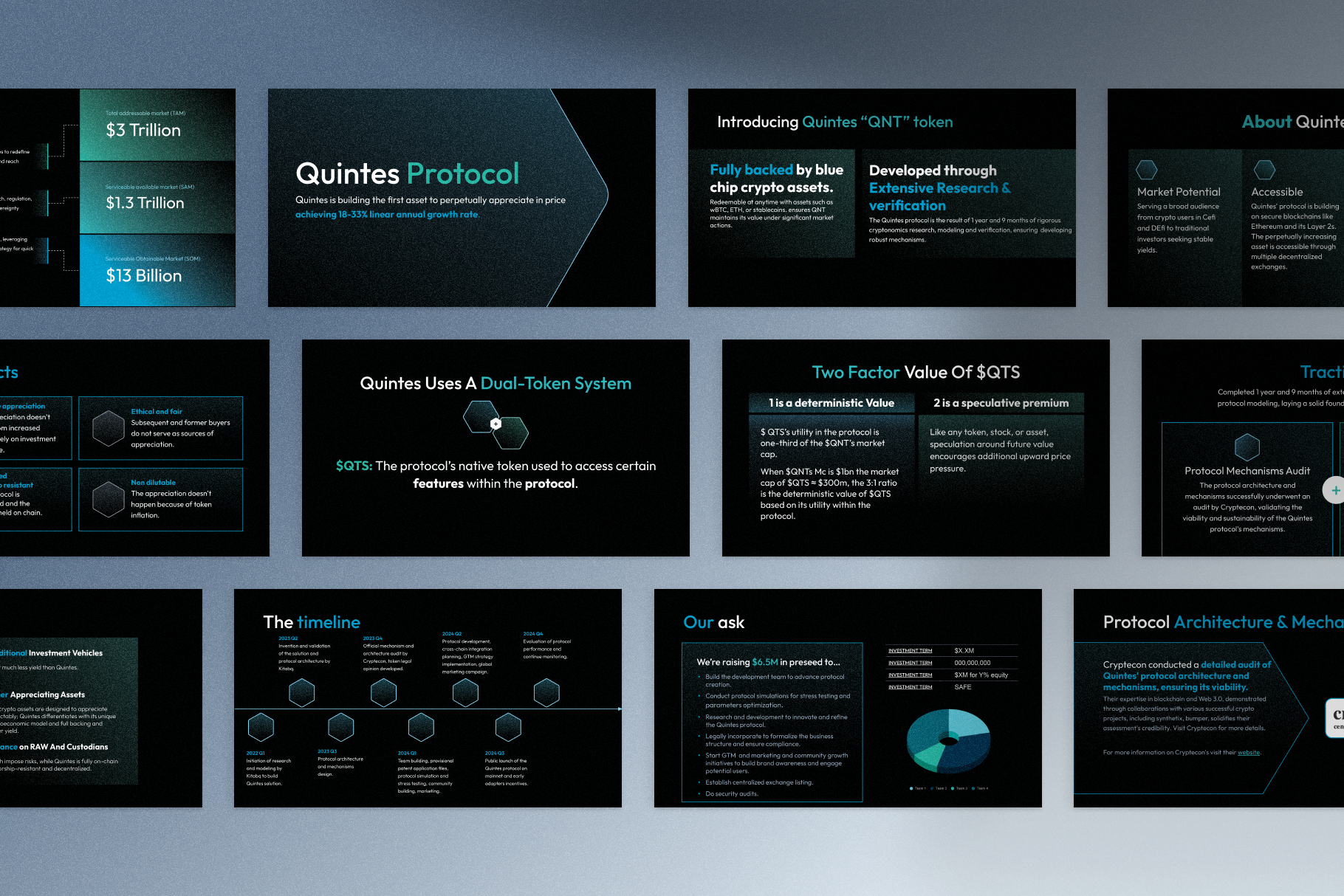
Quintes, a blockchain-powered platform designed to tokenize real-world assets, faced challenges in creating a pitch deck that effectively communicated its value to investors. Here’s how these challenges were addressed to craft a compelling, data-driven, and visually appealing presentation.
Challenges in the Initial Pitch Deck
1. Design
- Problem: The original slides were cluttered, lacked visual hierarchy, and used inconsistent branding.
- Impact: The lack of cohesive design reduced professionalism and failed to inspire confidence in investors.
2. Copy
- Problem: Generic and overly technical messaging didn’t effectively communicate the value of fractional ownership or differentiate Quintes from competitors.
- Impact: Left investors unclear about the problem Quintes was solving and its unique value proposition.
3. Research
- Problem: Limited use of market data and industry trends to validate the opportunity.
- Impact: Undermined the credibility of the pitch and left investors questioning the market’s potential for tokenized assets.
4. Narrative
- Problem: The deck lacked a cohesive storytelling arc, with slides feeling disconnected and overly focused on technical details.
- Impact: Investors struggled to follow the vision and connect with the business opportunity.
5. Tokenomics Transparency
- Problem: The tokenomics model was poorly explained, with insufficient details on token utility, distribution, and revenue streams.
- Impact: Created doubts about the sustainability and scalability of the project.
6. Strategy
- Problem: The pitch deck lacked a clear structure and logical flow, burying critical points under unnecessary details.
- Impact: Reduced the overall impact of the presentation, making it harder for investors to focus on the key takeaways.
Our Approach and Solution
A comprehensive strategy was developed to address these issues, ensuring that the pitch deck effectively communicated Quintes’ potential as an investment opportunity.
1. Design
- Introduced a clean, modern aesthetic aligned with Quintes’ branding.
- Used professional visuals, including flowcharts and pie charts, to simplify complex ideas like tokenization and tokenomics.
- Highlighted the platform’s functionality with intuitive graphics and polished layouts.
2. Copy
- Crafted messaging that clearly articulated the problem and solution while avoiding excessive jargon.
- Highlighted Quintes’ unique value proposition: democratizing investment through blockchain technology.
- Reframed key points to directly address investor priorities, such as scalability, market potential, and ROI.
3. Research
- Conducted in-depth market research, integrating key statistics like the $280 trillion global market for real-world assets.
- Provided supporting data on blockchain adoption trends and the growth of tokenized markets to validate the business opportunity.
4. Narrative
- Developed a compelling story arc, starting with the market pain point, transitioning into Quintes’ solution, and concluding with the opportunity for growth and scalability.
- Ensured that every slide built on the previous one to create a seamless flow investors could follow easily.
5. Tokenomics Transparency
- Added a detailed tokenomics slide, including:
- Token Utility: Explained how the token powers transactions, governance, and staking within the platform.
- Supply Allocation: Provided a breakdown of token distribution (e.g., 40% for rewards, 20% for operations).
- Revenue Streams: Showed how sustainable income would be generated through transaction fees, asset listing fees, and staking rewards.
- Used visuals like pie charts to simplify token distribution for investors.
6. Strategy
- Designed a strategic deck flow emphasizing the core questions investors care about:
- What is the problem?
- How does Quintes solve it?
- Why is this the right time for the solution?
- Why is the team capable of executing this vision?
- Incorporated an “Ask” slide to clearly outline funding requirements and allocation plans (e.g., “Raising $10M for development, marketing, and scaling”).
Results
The revamped pitch deck successfully addressed the initial shortcomings and positioned Quintes as a credible, scalable, and high-potential blockchain project. Key outcomes included:
1. Investor Engagement
- The professional design, intuitive visuals, and clear messaging captured investor attention and communicated the platform’s value effectively.
2. Credibility
- Detailed market research, well-justified tokenomics, and an engaging narrative built trust with investors, addressing key concerns about sustainability and scalability.
3. Memorability
- The polished, data-driven deck left a lasting impression, with its seamless narrative and strong focus on market potential ensuring Quintes stood out in a competitive crypto landscape.
For a detailed breakdown, view the full case study here.
Advanced Insights for Crafting a Pitch Deck For Your Crypto Investment That Converts
These are things no advisor, startup event organizer or coach will tell you for free. We’ve done the research and combined it with our experience to give you these insights with no strings attached.
Token Utility and Distribution
When developing a crypto pitch deck, understanding and effectively presenting token utility and distribution is paramount. This aspect is not only crucial for attracting investors but also for the long-term success of your project.
Token Utility: Token utility refers to the various roles a token plays within its ecosystem. Common utilities include:
- Payments: Tokens are often used for transactions within their ecosystem.
- Governance: Some tokens allow holders to participate in decision-making processes.
- Staking: Tokens can be staked to earn rewards and contribute to network security.
- Access: Tokens might provide access to specific features or services.
The utility of a token is a significant factor in determining its long-term value and adoption. A token with strong utility is more likely to be sought after, potentially increasing its demand and price.
Token Distribution: Token distribution involves allocating tokens among different stakeholders, including team members, investors, and the community. Effective token distribution is essential for several reasons:
- Network Security: Broad distribution can enhance network security, especially in Proof-of-Stake systems.
- Credibility and Community Engagement: A transparent and equitable distribution model boosts a project’s credibility and encourages community participation.
- Flexibility: Tokens can offer various engagement mechanisms for stakeholders, enhancing the dynamic nature of the project.
The distribution model should align with your project’s goals, offering incentives for long-term positive decisions and avoiding centralization issues. It’s crucial to maintain transparency in this process to build trust among investors and users.
Action Steps for Effective Token Distribution:
- Conduct Thorough Research: Before determining your token distribution strategy, research legal and technical aspects thoroughly to ensure compliance and soundness. Consider the impacts of different allocation strategies on the project’s long-term success.
- Community Building and Engagement: Build a community around your project before distribution. This ensures initial support and promotes active participation. Engage with your community via platforms like Discord or Telegram.
- Develop a Clear Tokenomics Model: Define your token’s total supply, pricing, utility, and allocation strategy. This includes determining the proportion of tokens allocated to different stakeholders like the team, advisors, and the public.
- Implement Transparent Processes: Maintain transparency throughout the distribution process. This builds trust and credibility, and ensures that stakeholders are aware of the distribution mechanics and their implications.
- Legal Compliance and Consulting: Engage with legal advisors to ensure that your token distribution complies with relevant laws and regulations, especially considering the rapidly evolving landscape of cryptocurrency regulation.
- Smart Contract Development and Auditing: Develop and audit your smart contracts thoroughly to ensure security and functionality. Use tools like Remix IDE, Truffle Suite, and get third-party security audits from firms like Quantstamp or OpenZeppelin.
- Effective Marketing and Public Relations: Implement comprehensive marketing strategies to attract a broader audience. This can include leveraging influencers and media outlets to increase visibility for your token distribution event.
- Post-Launch Support and Updates: After the distribution, continue to provide robust customer support and regular updates to stakeholders through social media and community channels. This ensures ongoing engagement and trust in the project.
Roadmap Presentation
A roadmap in a crypto pitch deck is a critical component that outlines the project’s future plans, key milestones, and timelines. It’s essential for attracting investors and gaining credibility in the crypto space.
Importance of Roadmap Presentation:
- Clarity and Direction: A roadmap provides a clear vision of where the project is heading. It outlines the goals and the strategic steps the project will take to achieve them. This clarity is crucial for investors to understand the project’s potential and longevity.
- Investor Confidence: A well-defined roadmap can significantly boost investor confidence. It demonstrates that the project team has a clear plan and is committed to delivering on its promises.
- Measurable Progress: By presenting
A roadmap in a crypto pitch deck is a critical component that outlines the project’s future plans, key milestones, and timelines. It’s essential for attracting investors and gaining credibility in the crypto space.
Importance of Roadmap Presentation:
- Clarity and Direction: A roadmap provides a clear vision of where the project is heading. It outlines the goals and the strategic steps the project will take to achieve them. This clarity is crucial for investors to understand the project’s potential and longevity.
- Investor Confidence: A well-defined roadmap can significantly boost investor confidence. It demonstrates that the project team has a clear plan and is committed to delivering on its promises.
- Measurable Progress: By presenting a timeline of key milestones, the roadmap allows both the team and the investors to track progress. This helps in assessing the project’s development and success over time.
- Market Positioning and Strategy: The roadmap also showcases the project’s strategic approach to capturing market opportunities, adapting to industry trends, and tackling potential challenges.
- Transparency and Trust: A detailed and realistic roadmap conveys transparency, helping to build trust among potential investors and the community.
Actions to Take for Effective Roadmap Presentation:
- Set Realistic Milestones: Establish clear, achievable milestones. Overly ambitious or vague milestones can lead to skepticism and lack of trust.
- Timeline Specificity: Be specific about the timeline for each phase of your project. Include estimated dates or timeframes for key deliverables.
- Demonstrate Adaptability: Show how your roadmap can adapt to potential changes in the crypto market or technology. This indicates flexibility and foresight.
- Highlight Key Achievements: If your project has already accomplished significant milestones, highlight these in the roadmap to demonstrate a track record of success.
- Link Milestones to Goals: Ensure that each milestone directly contributes to the overarching goals of the project. This demonstrates a well-thought-out strategy.
- Regular Updates and Revisions: Be prepared to update your roadmap as the project progresses. This shows that you are responsive and committed to meeting your objectives.
- Visual Presentation: Use engaging visuals to make your roadmap easy to understand. A well-designed visual roadmap can be more impactful than text-heavy slides.
- Risk Management Plan: Include a section on how your project plans to manage potential risks and challenges. This can cover anything from market volatility to technological hurdles, showing that your team is prepared to handle uncertainties.
- Community and Investor Involvement: Illustrate how you plan to involve the community and investors in your roadmap. This could include beta testing, feedback loops, or governance participation, emphasizing the project’s community-driven approach.
- Integration with Broader Ecosystem: Highlight how your project’s development stages will integrate with and contribute to the broader cryptocurrency ecosystem. This might involve partnerships, interoperability with other platforms, or contributions to open-source projects.
Team and Advisors
In the context of a crypto pitch deck, the team and advisors’ section is a crucial element that significantly influences investors’ perception and trust in the project. This section showcases the experience, expertise, and credibility of the individuals behind the project.
Importance of Highlighting Team and Advisors:
- Expertise and Experience: In the rapidly evolving crypto space, the expertise and experience of the team are paramount. Investors look for a team with a strong background in blockchain technology, cryptography, finance, and
Financial Projections and Funding
In a crypto pitch deck, the Financial Projections and Funding section is pivotal as it provides a clear picture of the project’s financial health, sustainability, and growth potential. This section is particularly scrutinized by investors, as it indicates the feasibility and profitability of the crypto project.
Importance of Financial Projections and Funding in a Crypto Pitch Deck:
- Credibility and Realism: Accurate and well-thought-out financial projections demonstrate the team’s understanding of the market and the economic dynamics of their project. It adds credibility and shows that the team is realistic about their goals.
- Investment Appeal: Clear financial projections give potential investors insight into the project’s potential for profitability, helping them assess the return on investment.
- Funding Requirements and Utilization: This section details how much funding is needed and how it will be utilized. It is essential for investors to know that their money will be used efficiently and strategically to grow the project.
- Revenue Model Clarity: For crypto projects, it’s crucial to explain how the project will generate revenue. This could be through transaction fees, token sales, services offered, or any other monetization strategies specific to the project.
- Market Viability and Scalability: Financial projections help to demonstrate the project’s viability in the current market and its potential to scale. This is particularly important in the fast-evolving crypto industry.
Exit Strategy
The Exit Strategy section in a crypto pitch deck is crucial for showcasing the long-term vision and sustainability of the project. It addresses how the founders and investors can expect to realize a return on their investment, which is a key concern for anyone putting capital into a new venture.
Importance of an Exit Strategy in a Crypto Pitch Deck:
- Investor Confidence: An exit strategy reassures investors that the team has thought about the future and has a plan for generating returns. This is particularly important in the volatile and uncertain crypto market.
- Sustainability and Long-term Planning: A clear exit strategy indicates that the project is not just a short-term endeavor but has a sustainable and long-term business model. This can include plans for an acquisition, merger, initial public offering (IPO), or token buybacks.
- Risk Management: It also demonstrates the team’s awareness and management of risks, showing that they have considered various scenarios and have plans in place to protect investors’ interests.
Actions to Take for an Effective Exit Strategy Presentation:
- Outline Potential Scenarios: Provide details on different exit scenarios such as strategic acquisitions, mergers, or an IPO. For crypto projects, this could also include token buybacks or converting tokens into equity in case of a business pivot.
- Demonstrate Market Understanding: Show your understanding of the current and future market conditions that could affect exit opportunities. This might involve analysis of market trends, potential acquirers, and the general investment climate.
- Link to Business Model: Make sure your exit strategy aligns with your overall business model and the unique aspects of your crypto project. For example, if your project is about a decentralized application (dApp), discuss how the dApp’s growth and adoption can lead to lucrative exit opportunities.
- Discuss Timeframe: Provide a realistic timeframe for your exit strategy. This helps set expectations for investors regarding the liquidity of their investment.
- Legal and Regulatory Compliance: Ensure that your proposed exit strategy complies with all relevant legal and regulatory requirements, particularly those pertaining to cryptocurrencies and digital assets.
- Stakeholder Interests: Address how different stakeholders, including early investors, team members, and token holders, will be treated in various exit scenarios. This can include details on token buyback programs, equity conversions, or distribution of proceeds from a sale or IPO.
- Contingency Plans: Include contingency plans for unforeseen circumstances or market changes. This shows that the team is prepared to pivot or adapt their strategy as needed.
Visual Design of the Deck
The visual design of a crypto pitch deck plays a critical role in how the information is perceived and received by potential investors. Good design not only enhances the aesthetic appeal of the pitch deck but also aids in effectively communicating the key messages and concepts of the project.
Importance of Visual Design in a Crypto Pitch Deck:
- First Impressions Matter: The visual appeal of your pitch deck can make a significant first impression. A well-designed deck signals professionalism and attention to detail, which are crucial in building trust and credibility.
- Enhanced Comprehension: Visual elements such as graphs, charts, and infographics can make complex data and technical information more digestible and easier to understand, which is especially important in the often complex realm of cryptocurrency.
- Brand Identity and Consistency: The design should reflect the project’s brand identity. Consistent use of colors, fonts, and style elements helps in creating a cohesive and memorable brand image.
- Engagement and Interest: A visually engaging pitch deck keeps the audience’s attention focused and makes the presentation more interesting and less monotonous.
Actions to Take for Effective Visual Design:
- Use Professional Design Tools: Utilize professional design software or platforms (like Adobe Creative Suite, Canva, etc.) to ensure high-quality visuals. For crypto-specific content, consider using tools that can accurately represent blockchain concepts.
- Keep It Clean and Uncluttered: Avoid overcrowding slides with too much information or too many visuals. Aim for a clean, uncluttered design that makes key points stand out.
- Incorporate Relevant Visuals: Use visuals that are relevant to the crypto industry, such as blockchain diagrams, flowcharts of token circulation, and market trend graphs. Custom illustrations can also be used to explain complex concepts like smart contracts or decentralized applications.
- Consistent Branding: Maintain consistency in your branding throughout the pitch deck. Use your project’s color scheme, logo, and typography consistently across all slides.
- Data Visualization: Implement clear and concise data visualizations to represent financial projections, market analysis, and tokenomics. Tools like Tableau or Microsoft Excel can be helpful for creating impactful charts and graphs.
- Interactive Elements: If presenting digitally, consider incorporating interactive elements like clickable content or embedded videos, especially when explaining technical aspects of the project.
- Quality Over Quantity: Choose quality over quantity. Each visual element should serve a purpose and add value to the slide. Avoid unnecessary decorations that can distract from the main content.
- Professional Review or Feedback: If possible, get your pitch deck reviewed by a professional designer or someone with experience in crypto pitch decks to provide feedback on the design aspects.
Problem, Solution, and Market Opportunity
The Problem, Solution, and Market Opportunity section is a crucial part of a crypto pitch deck. It’s where you define the specific issue your project addresses, present your unique solution, and highlight the market potential. This section is critical for convincing investors of the viability and necessity of your project in the crypto space.
Importance of Problem, Solution, and Market Opportunity in a Crypto Pitch Deck:
- Establishing Relevance and Need: Clearly defining the problem sets the stage for why your project is necessary. In the crypto world, this could be anything from improving blockchain scalability to enhancing privacy in digital transactions.
- Demonstrating Innovation and Uniqueness: Your solution should not only address the problem but also showcase your project’s unique approach. This could involve innovative use of blockchain technology, unique tokenomics, or novel applications of smart contracts.
- Highlighting Market Potential: Investors are particularly interested in the size and growth potential of the market you’re targeting. This could involve discussing the increasing adoption of blockchain technology, the expansion of decentralized finance (DeFi), or the growing demand for non-fungible tokens (NFTs).
Actions to Take for an Effective Presentation of Problem, Solution, and Market Opportunity:
- Thoroughly Research the Problem: Conduct in-depth research to understand and articulate the problem clearly. This might involve analyzing current pain points in the crypto market, such as transaction speeds, fees, or security vulnerabilities.
- Detail Your Solution: Explain how your project solves the identified problem. Be specific about your technology, processes, or services, and how they differ from existing solutions. Use case studies or examples if available.
- Quantify the Market Opportunity: Provide data and statistics to support the size and growth potential of the market. This can include market research reports, trends in cryptocurrency adoption, or statistical forecasts.
- Use Visual Aids: Leverage graphs, charts, and infographics to make your point more effectively. For instance, use a graph to show the growth of the DeFi market or an infographic to explain how your blockchain solution works.
- Address the Competitive Landscape: Acknowledge existing solutions and competitors, and clearly state how your project is different or better. This can involve a comparative analysis showing your advantages in terms of technology, cost, efficiency, or market reach.
- Include Testimonials or Endorsements: If available, include testimonials from beta testers, industry experts, or early adopters to add credibility to your claims.
- Link Solution to Revenue Generation: Explain how your solution will generate revenue. This could be through transaction fees, subscription models, or by providing a platform for other services.
- Address Scalability and Sustainability: Discuss how your solution is scalable and sustainable in the long term. This is particularly important in the rapidly evolving crypto landscape.
Competition Analysis
In a crypto pitch deck, the Competition Analysis section is crucial for demonstrating a deep understanding of the market landscape and your project’s positioning within it. This analysis helps to identify and articulate your unique advantages and how you plan to capture a share of the market.
Importance of Competition Analysis in a Crypto Pitch Deck:
- Understanding the Market Landscape: A thorough analysis of competitors allows you to understand the current market landscape in the crypto space. It highlights the strengths and weaknesses of existing solutions and reveals gaps that your project can fill.
- Highlighting Unique Selling Proposition (USP): By comparing your project with competitors, you can clearly define what sets your project apart (your USP). This could be advanced technology, better security features, lower fees, faster transactions, or a more user-friendly interface.
- Building Credibility with Investors: Showing that you have a comprehensive understanding of your competitors reassures investors that you are aware of market dynamics and are prepared to face market challenges.
- Strategic Planning and Positioning: Competition analysis aids in strategic planning by helping to identify potential threats and opportunities in the market. It guides how you position your project to stand out or complement existing solutions.
Actions to Take for an Effective Competition Analysis:
- Identify Key Competitors: Research and list down the key players in the space that your project is targeting. This could include both direct competitors (projects with similar offerings) and indirect competitors (projects that could pivot to compete with your offering).
- Analyze Competitors’ Strengths and Weaknesses: For each competitor, analyze their strengths, weaknesses, and market strategies. Look at aspects such as their technology, market share, funding, community engagement, and any other relevant factors.
- Compare Features and Offerings: Create a comparison chart or table that contrasts your project’s features and offerings with those of competitors. Highlight areas where your project excels or offers something unique.
- Understand Competitors’ Market Position: Analyze how competitors are positioned in the market. Are they targeting the same audience segments as you? What has been their approach to marketing and user acquisition?
- Gather Market Feedback and Opinions: Use surveys, social media, or industry forums to gather feedback about what users like or dislike about your competitors’ solutions. This can provide insights into how to differentiate your project.
- Keep Updated with Industry Trends: Stay informed about the latest trends and developments in the cryptocurrency industry. New competitors can emerge quickly, and existing ones can pivot, affecting your project’s competitive landscape.
- Leverage Blockchain-Specific Data: Utilize blockchain analytics tools to gather data on competitors’ transaction volumes, token distribution, and user activity. This can provide concrete data to back up your analysis.
- Plan for Future Competition: Consider potential future competitors, especially those outside the traditional crypto space that might enter the market.
Business Model Explanation
In a crypto pitch deck, the Business Model Explanation is vital as it conveys how your project intends to create value and generate revenue. This section is critical for investors, as it demonstrates the project’s potential for sustainability and profitability in the dynamic crypto market.
Importance of Business Model Explanation in a Crypto Pitch Deck:
- Demonstrates Revenue Generation Potential: Clearly articulating your business model shows how your project will generate revenue, which is a primary concern for investors. It encompasses various aspects such as transaction fees, subscription models, or other monetization strategies specific to the crypto space.
- Builds Investor Confidence: A well-defined business model helps build investor confidence by showing that the project has a clear plan for becoming financially sustainable and profitable.
- Clarifies Value Proposition: The business model should align with the value proposition of your crypto project. Whether it’s a new cryptocurrency, a blockchain platform, or a decentralized application, the model should clearly outline how it creates value for users.
- Highlights Market Fit: It demonstrates how your project fits into the existing market, addressing current demands and how it stands out from competitors.
Actions to Take for an Effective Business Model Explanation:
- Define Revenue Streams: Clearly outline the primary revenue streams of your project. For a crypto project, this could include transaction fees, staking rewards, premium features for additional services, or revenue sharing from partnerships.
- Explain Tokenomics: If your project involves a token, explain the tokenomics clearly. This includes token distribution, utility, how it drives the ecosystem, and its role in revenue generation.
- Detail Cost Structure: Provide an overview of the cost structure of your business. This should include development costs, marketing expenses, operational costs, and any other significant expenditures.
- Market Size and Target Audience: Explain the size of the market you are targeting and the specific audience segments. Show how your business model addresses the needs and preferences of these segments.
- Competitive Pricing Strategy: If applicable, discuss your pricing strategy in comparison to competitors. Explain how your pricing model is attractive to users while ensuring sustainability.
- Scalability Potential: Discuss how your business model can scale. In the crypto space, this might involve expanding to different blockchain platforms, adding new features, or growing the user base.
- Legal and Regulatory Compliance: Address how your business model complies with current regulations in the crypto space. This is crucial for building credibility and trust with investors.
- Use Case Scenarios: Provide real-world use case scenarios that demonstrate how your business model works in practice. This could include case studies or hypothetical scenarios that show the practical application of your crypto solution and how it generates revenue.
- Financial Projections: Include financial projections that align with your business model. These should cover projected revenue, break-even analysis, and growth forecasts. Make sure these projections are realistic and based on sound assumptions.
- Monetization Strategy Beyond Initial Funding: Elaborate on your long-term monetization strategy beyond initial coin offerings (ICOs), token sales, or seed funding. Investors are interested in how the project will sustain itself and grow financially in the long run.
- Risk Analysis: Conduct and present a risk analysis related to your business model. This should include potential market risks, competitive risks, and regulatory risks, along with strategies to mitigate these risks.
- Continual Adaptation and Innovation: Emphasize your commitment to continual adaptation and innovation within your business model, which is essential in the rapidly evolving crypto market.
Customer or Market Strategy
The Customer or Market Strategy section of a crypto pitch deck is essential for demonstrating how your project plans to capture and retain a significant share of the market. This strategy outlines who your target customers are, how you plan to reach them, and how you will maintain their engagement and loyalty in the competitive crypto landscape.
Importance of Customer or Market Strategy in a Crypto Pitch Deck:
- Target Market Identification: Clearly defining your target market helps investors understand who will use your product or service. In the crypto world, this could range from tech-savvy blockchain enthusiasts to businesses looking for blockchain solutions.
- Effective Market Penetration: This section shows your plan for entering the market. Whether it’s through strategic partnerships, community building, or innovative marketing tactics, it demonstrates how you will attract your first users.
- User Retention and Engagement: Beyond acquisition, it’s crucial to show strategies for user retention and engagement, which are key drivers for long-term success in the crypto industry.
- Competitive Advantage: Outlining your market strategy helps highlight your competitive edge, whether it’s through superior technology, better user experience, unique features, or effective community engagement.
Actions to Take for an Effective Customer or Market Strategy:
- Define Your Ideal Customer Profile: Identify and describe your ideal customer. This could include demographics, behaviors, preferences, and pain points specific to the crypto market.
- Market Research and Analysis: Conduct thorough market research to understand the size, trends, and dynamics of the crypto market. Use this data to inform your strategy and ensure it’s tailored to market needs.
- Marketing and Promotion Plan: Develop a detailed marketing plan. This might include online marketing (SEO, social media, content marketing), attending crypto conferences, or leveraging influencer partnerships within the crypto community.
- Community Building: Plan for community building, especially on platforms popular in the crypto world like Discord, Telegram, or Reddit. Community support is crucial in the crypto industry for fostering trust and loyalty.
- Partnership and Collaboration Strategy: Identify potential strategic partnerships with other crypto projects, platforms, or influencers that can help you reach a wider audience.
- User Experience and Service: Focus on providing an exceptional user experience, whether it’s through a user-friendly interface, customer support, or added services like educational resources about crypto and blockchain.
- Feedback Loop and Adaptation: Implement a system for collecting user feedback and continuously adapting your strategy based on this feedback. In the rapidly evolving crypto market, being responsive to user needs and market changes is crucial.
- Token Utilization and Incentives: If your project involves a cryptocurrency or a token, explain how it will be used within your ecosystem to attract and retain customers. This could include loyalty programs, staking rewards, or special access to services.
- Regulatory Compliance: Ensure that your market strategy is compliant with the regulations in the jurisdictions you are targeting. This is particularly important in the crypto industry, where regulatory landscapes can vary significantly across regions.
- Educational Initiatives: Given the complexity of blockchain and crypto, consider including educational content in your strategy to help your target market understand your product and the technology behind it.
- Personalization and Segmentation: Tailor your approach to different segments of your target market. Personalization can be a key differentiator in a market with diverse customer needs and preferences.
- Metrics and KPIs: Define clear metrics and key performance indicators (KPIs) to measure the success of your market strategy. This could include user acquisition rates, engagement metrics, conversion rates, and retention rates.
Use of Funds
The “Use of Funds” section in a crypto pitch deck is critical for investors, as it provides transparency and insight into how their capital will be allocated and utilized. This section helps build trust and credibility, showing that the project’s team is responsible and has a clear plan for using the funds to achieve the project’s goals.
Importance of Use of Funds in a Crypto Pitch Deck:
Transparency and Trust: Clearly outlining how the funds will be used demonstrates transparency and helps to build trust with potential investors. It shows that the project’s leaders have a clear plan and are accountable for the resources.
Use these insights and make a winning pitch. If you want to talk about them, reach out to me and book a call.
FAQ
1. What is the purpose of a crypto pitch deck?
A crypto pitch deck is a presentation tool used to communicate the core value proposition, technical solution, and investment opportunity of a blockchain-based project. Its primary goal is to secure funding from investors, form strategic partnerships, or build credibility with stakeholders by clearly outlining the problem, solution, market opportunity, tokenomics, and roadmap.
2. What key slides should be included in a crypto pitch deck?
A strong crypto pitch deck typically includes the following slides:
- Cover Slide (project name, tagline, and branding).
- Problem Statement (specific pain points in the market).
- Solution Slide (how your project solves the problem).
- Market Opportunity (TAM/SAM/SOM and trends).
- Tokenomics (utility, supply, and distribution).
- Traction Slide (early milestones, partnerships, or MVP).
- Team Slide (founders, advisors, and their qualifications).
- Roadmap (short- and long-term milestones).
- Competitive Analysis (what sets you apart from others).
- The Ask (how much funding you need and how it will be used).
3. How does a crypto pitch deck differ from a traditional startup pitch deck?
A crypto pitch deck has unique components specific to blockchain projects, such as:
- Tokenomics: Explains the token utility, supply, and revenue model.
- Decentralization Model: Shows how the platform operates without central authority.
- Regulatory Compliance: Addresses legal considerations like KYC/AML compliance.
- Blockchain-Specific Metrics: Highlights metrics like Total Value Locked (TVL), staking rewards, or transaction throughput (TPS).
These components cater to crypto investors who expect more technical and token-related details than traditional startup VCs.
4. What do investors look for in a crypto pitch deck?
Crypto investors prioritize the following:
- Scalability: Can the project handle mass adoption?
- Tokenomics: Is the token model sustainable and profitable?
- Market Potential: How large is the addressable market?
- Traction: Are there measurable results, like partnerships or users?
- Team Credibility: Does the team have relevant experience and expertise?
- Clear Use Case: Is the solution solving a real-world problem?
- Compliance: Is the project aware of and prepared for regulatory requirements?
5. How do you effectively communicate tokenomics in a pitch deck?
To communicate tokenomics effectively:
- Define token utility: Explain how the token will be used within the ecosystem (e.g., governance, staking, fees).
- Provide a supply breakdown: Show allocation percentages (e.g., for founders, investors, community rewards).
- Highlight value appreciation mechanisms: Describe deflationary models (e.g., token burns) or staking incentives that increase demand.
- Ensure clarity: Use visual aids like pie charts or flow diagrams to make complex models easier to understand.
6. What are common mistakes to avoid in a crypto pitch deck?
- Overloading with jargon: Avoid excessive technical terms that alienate non-crypto-savvy investors.
- Unclear tokenomics: If your token model is confusing or lacks transparency, investors will hesitate.
- Exaggerated market claims: Avoid inflated projections or overly optimistic assumptions that lack supporting data.
- No roadmap: Investors want to see clear milestones for project development.
- Ignoring competition: Failing to acknowledge competitors shows a lack of market awareness.
7. How important is the design of the pitch deck?
Design plays a critical role in creating a professional and engaging pitch deck. Key design principles include:
- Visual clarity: Use clean, consistent layouts to make information digestible.
- Minimal text: Use bullet points and visuals instead of paragraphs.
- High-quality graphics: Include charts, diagrams, and infographics to simplify complex ideas.
- Professional branding: Ensure the design reflects your project’s professionalism and credibility.
8. What role does storytelling play in a crypto pitch deck?
Storytelling is crucial for engaging investors and making your project memorable. A great crypto pitch deck tells a story that:
- Defines the problem: Start with a relatable or data-backed pain point.
- Builds anticipation: Explain how your solution addresses the problem in a unique way.
- Demonstrates potential: Use visuals and data to show scalability and impact.
- Inspires confidence: Conclude with your team’s qualifications, traction, and a clear funding ask.
9. How can you make your crypto pitch deck stand out?
To make your deck stand out:
- Be concise: Stick to the essentials and avoid overwhelming slides.
- Highlight traction: Show real results, such as partnerships, users, or TVL.
- Showcase innovation: Emphasize what makes your blockchain solution unique.
- Customize for investors: Tailor your deck to the specific audience (e.g., institutional VCs vs. crypto whales).
- Use engaging visuals: Incorporate diagrams, token allocation charts, and product mockups.
10. What are investors’ biggest concerns when reviewing a crypto pitch deck?
Investors often have concerns around:
- Regulatory Risks: Is the project compliant with KYC/AML regulations or prepared for future legal challenges?
- Tokenomics Sustainability: Will the token retain value or face inflationary pressure?
- Team Reliability: Does the team have the experience to execute the vision?
- Scalability and Adoption: Can the project handle real-world demand?
- Market Differentiation: What’s the competitive edge, and how does it defend against existing players?
Alternatively, book a call and get the full pitch deck done. Hands-off.
Related crypto pitch deck resources


13 Slide Decentralized Data Management Pitch Deck Template | Google Slides

14 Slide Decentralized Spatial Streaming Pitch Deck Template | Google Slides
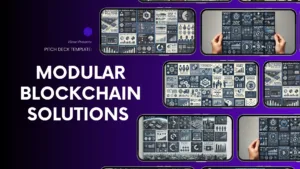
14 Slide Pitch Deck Template That Connects with Investors’ Pain Points
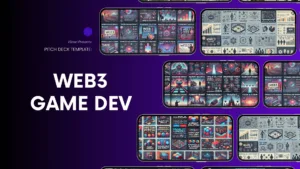

Viktori. Pitching your way to your next funding.
Locations
Office 1: 633 North Wells Street Chicago, IL, United States, 60654
HQ: Boulevard P.O. 10000 Skopje, North Macedonia
Pitch Deck Resources
Case Studies
Client Reviews

